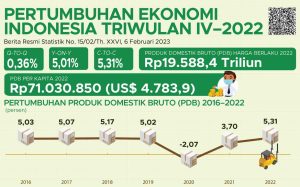Indonesia’s Economy Grows by 5.31% in 2022

PR of Statistics Indonesia (BPS)
Indonesia’s economy grew by 5.31 percent (year-on-year/yoy) in 2022, according to the Statistics Indonesia (BPS). The positive growth of the country’s domestic economy is contributed by the 5.01 percent increase of the growth in the fourth quarter of 2022.
Coordinating Minister for Economic Affairs Airlangga Hartarto, Monday (02/07), stated that the country’s 2022 economic growth is higher than that of pre-pandemic period.
Although Indonesia’s economy recorded a negative growth during COVID-19 pandemic in 2020, it gradually showed resilience to recover faster. Airlangga said that various policies and constructive strategies adopted by the Government including the COVID-19 handling and national economic recovery program are keys to determining a success in driving the national economy.
“In 2022, COVID-19 handling and national economic recovery [program] are keys for the success,” he said.
In term of demand, components of the Government expenditure at the fourth quarter of 2022 managed to grow steadily. In addition, exports grew by 14.93 percent (yoy) and imports managed to grow by 6.25 percent (yoy) which is driven by an increase in raw material imports.
“The main contributor to the GDP (Gross Domestic Product) is consumption sector. This sector grew by 4.48 percent yoy. Meanwhile, investment sector and gross fixed capital investment (PMTB) grew by 3.33 percent, and household consumption grew by 5.7 percent,” he said adding that government consumption saw a contraction of 4.77 percent yoy.
In term of supply, all business sectors have managed to record positive growth in the fourth quarter of 2022. The most contributed sectors are transportation and warehouse with 16.99 percent of growth, followed by accommodation and food and beverage sectors with 13.81 percent of growth. The growth was contributed by the increase in domestic and foreign tourist arrival.
In addition, processing industry which grew by 5.64 percent also made a significant contribution to the GDP.
Based on region, Java is the main contributor to the national economic growth with 56.48 percent. Sumatra island came second with 22.04 percent of growth, followed by Kalimantan with 9.25 percent, Sulawesi 7.03 percent, and Maluku and Papua with 2.50 percent (yoy).
“Several leading indicators have bright prospects to sustain Indonesia’s economic growth amidst a slowdown in global economic performance. Domestic demand will remain the main pillar of the national economy in 2023. High CCI [consumer confidence index] reflects our optimism that our economy will be able to grow even stronger in the future,” he said.
Indicators from external sector are also managed to be under control reflected in the current account surplus, increasing foreign exchange reserves, positive exports and imports, flattened yield curve for government bonds, the strengthened rupiah exchange rate and the Indonesian Composite Index (IHSG).
“The Government will remain vigilant against the global economic slowdown which is projected to lower demand. In order to increase Indonesia’s economic resilience this year, domestic economic core will be strengthened through consumption and investment sectors,” he remarked. (JW/AIT/UN) (RAS/MUR)








